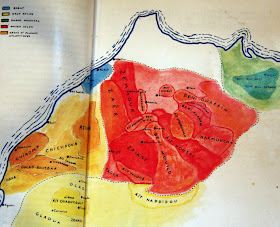So you are visiting Morocco and you want to buy a carpet? Or (more likely) you get shown some Moroccan carpets and fall in love with one. If your experience is the latter, then there is no need of a guide, simply your own taste and budget.
However, for those with the time and inclination, here is the first of a series of articles on the Berber carpets of Morocco.
The Tribes (click image to enlarge)
There are are around forty-five different tribal groups, each of which has distinctive designs and sometimes varying weaving and embroidery styles. In the first of these articles we will explore where the carpets come from, how to test if it is pure wool or a synthetic mix; and we will examine two very famous tribal design styles - that of the Zemmour and that of the Zaiane.
Top carpet is a pure wool Zemmour and the bottom one cotton and wool
Both of the Zemmour carpets are modern. This is usually recognised because of the intricate design work in the embroidery. In an older Zemmour the work is far less complex, as in the carpet below - a Zemmour whose age is around 80 years.
When a Zemmour is placed next to a carpet from the Zaiane Tribe, the difference is immediately obvious. The Zaiane has very distinctive lozenge shapes in the design.
In this example the Zaiane has raised wool tufting that is indicative of the style (but not exclusively so). The Zaiane come from further south in the Middle Atlas than the Zemmour and according to most reports are no longer producing carpets, so if you come across a Zaiane carpet it is likely to be old. A "new one" may well be a fake!
Above - detail of the tufting of wool in the Zaiane carpet. Below is another superb Zaiane carpet more than sixty years old and in superb condition. The high quality of the embroidery is a feature of all good Zaiane carpets
Our first tip is in regard to modern synthetics. How do you tell a synthetic carpet from one made from pure wool? Simple! With a cigarette lighter. Holding a flame under the tassels of a carpet will produce a very different result, depending on the material from which it is made.
In our next article we will explore more Berber carpet styles and look at the use of natural dyes in Morocco. For those looking for high quality Berber carpets we suggest you chat with the good folk at Coin Berbere. This is a trio of shops run by the Bouzidi-Idrissi family. You will find the shops on the Talaa Kebira in Fez. (phone 0535636946 email coinberbere@gmail.com











No comments:
Post a Comment